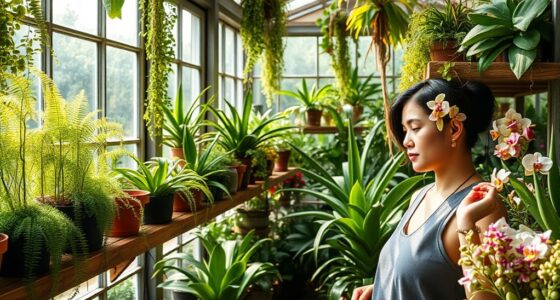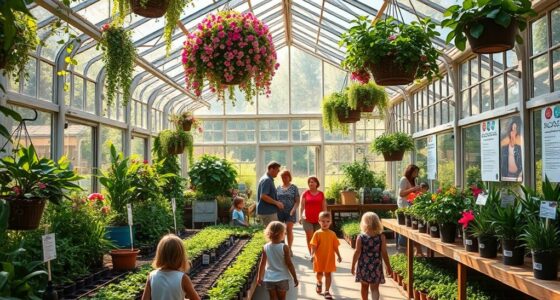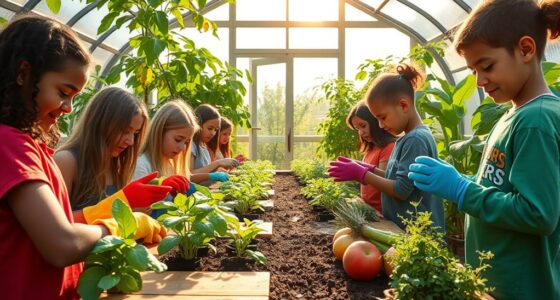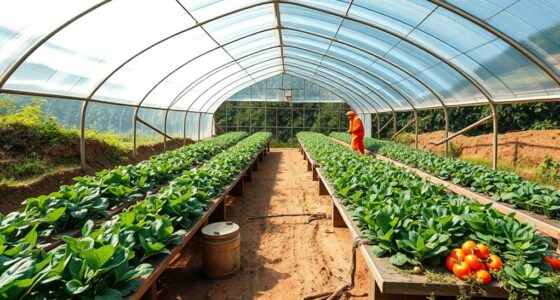Inclusive design in community growing spaces means creating accessible environments that welcome everyone, regardless of physical or sensory needs. You can incorporate raised beds, ergonomic tools, and adjustable seating to help all participate in gardening easily. Adding sensory features like fragrant plants, textured paths, and calming water sounds also makes the space engaging for diverse users. Focusing on genuine inclusion guarantees your community garden becomes a vibrant hub for everyone—find out how to make this happen.
Key Takeaways
- Incorporate adaptive gardening tools and raised beds to accommodate varying physical abilities.
- Design sensory-friendly features like fragrant plants, textured surfaces, and calming sound elements for inclusive engagement.
- Ensure pathways and seating areas are accessible and ergonomically designed for all users.
- Create quiet zones and natural retreat spaces to support sensory needs and promote comfort.
- Emphasize genuine inclusion by understanding diverse needs, fostering welcoming environments that encourage community participation.
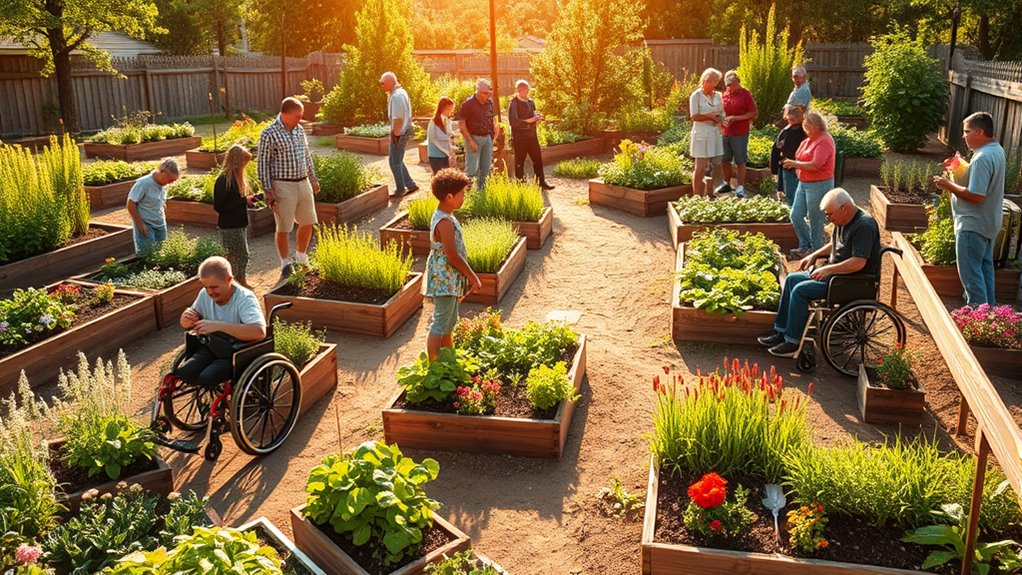
Have you ever wondered how community growing spaces can be designed to welcome everyone? Creating an inclusive environment means thinking beyond traditional layouts and considering how different individuals interact with the space. One key aspect is incorporating adaptive tools, which help remove barriers for people with varying abilities. These tools can include raised garden beds for those who have difficulty bending, ergonomic tools that reduce strain, or adjustable seating areas. When you use adaptive tools thoughtfully, you make it easier for everyone to participate in gardening activities, regardless of physical ability. It’s not just about accessibility; it’s about empowering everyone to connect with nature and grow food or flowers comfortably.
Designing community gardens with adaptive tools empowers everyone to enjoy gardening comfortably.
Sensory accessibility is another essential element in designing welcoming community growing spaces. This involves creating environments that cater to diverse sensory needs, ensuring that no one feels overwhelmed or excluded. For example, you can plant fragrant herbs like lavender or mint to offer pleasant scents for those with sensory sensitivities. Incorporating textured surfaces, such as gravel paths or soft mulch, provides tactile experiences that many find engaging. Bright, contrasting colors can also help individuals with visual impairments navigate the space more easily. By thoughtfully integrating sensory elements, you foster a space that is inviting and engaging for all users, including children, seniors, or people with sensory processing differences.
Additionally, designing for sensory accessibility involves managing sensory input to prevent overload. You might include quiet zones or shaded areas where people can retreat if they need a break from stimulation. Using natural elements like water features or wind chimes can create calming sounds that enhance the sensory experience without becoming overwhelming. The goal is to strike a balance—offering stimulating elements for some, while providing restful spaces for others. When you prioritize sensory accessibility, you show that everyone’s experience matters, encouraging more community members to participate and feel comfortable.
Incorporating adaptive tools and sensory accessibility features isn’t just about compliance; it’s about fostering genuine inclusion. When you design community growing spaces with these principles in mind, you create a vibrant, welcoming environment where everyone can thrive. It’s about recognizing that people have different needs and preferences and ensuring your space reflects that diversity. For example, understanding the importance of diverse user needs helps you create more effective and inclusive designs. By doing so, you open the door for more community members to connect with nature, learn new skills, and enjoy the many benefits that gardening and outdoor activities provide. Your thoughtful approach can transform an ordinary garden into a true community hub—accessible, engaging, and inclusive for all.
Frequently Asked Questions
How Can I Fund Inclusive Community Growing Spaces Effectively?
You can fund inclusive community growing spaces effectively by exploring diverse funding sources like grants, local government support, and community fundraising events. Focus on creating a garden layout that appeals to all, emphasizing accessibility and inclusivity. Engage your community early to build support and demonstrate the project’s value, which can attract more funding. Consistently showcase progress and the positive impact to secure ongoing investments and sustain your inclusive garden.
What Are the Best Practices for Engaging Diverse Community Members?
Think of engaging community members as tending a diverse garden; you need to nurture each plant with care. To do this effectively, prioritize cultural sensitivity and involve everyone through participatory planning. Listen actively to different voices, respect their perspectives, and create safe spaces for dialogue. By embracing diversity and fostering collaboration, you’ll cultivate a vibrant, inclusive community space where everyone feels valued and invested.
How Do I Ensure Safety for All Users in These Spaces?
You guarantee safety for all users by following accessibility standards and implementing clear safety protocols. Regularly inspect the space for hazards, maintain well-lit pathways, and provide easy-to-understand signage. Involve community members in safety planning to address diverse needs, and train staff on emergency procedures. By prioritizing accessible design and proactive safety measures, you create an inclusive environment where everyone feels secure and comfortable participating.
What Maintenance Strategies Support Long-Term Inclusivity?
Maintaining inclusivity is like tending a garden that blooms year-round. You should regularly update adaptive planting to accommodate changing needs and seasons, ensuring everyone can participate comfortably. Volunteer coordination keeps the space lively and cared for, fostering a sense of ownership. Consistent inspections and prompt repairs prevent barriers from forming, so all users feel welcome. By nurturing these strategies, you create a community space that truly grows with everyone.
How Can Technology Enhance Accessibility in Community Gardens?
You can enhance accessibility in community gardens by incorporating adaptive tools, like raised beds and ergonomic tools, that make gardening easier for everyone. Additionally, designing accessible pathways with smooth, wide surfaces guarantees all community members can navigate comfortably. By combining adaptive tools with accessible pathways, you create an inclusive environment that encourages participation and fosters a sense of community for people of all abilities.
Conclusion
By prioritizing inclusive design in your community growing spaces, you create environments everyone can enjoy and benefit from. Imagine wide, accessible paths, raised beds for easy gardening, and clear signage that welcomes all users. Some might think these features limit space or style, but they actually enhance usability and beauty for everyone. When you design with inclusion in mind, you foster a vibrant, welcoming community where every individual feels empowered to participate and thrive.



